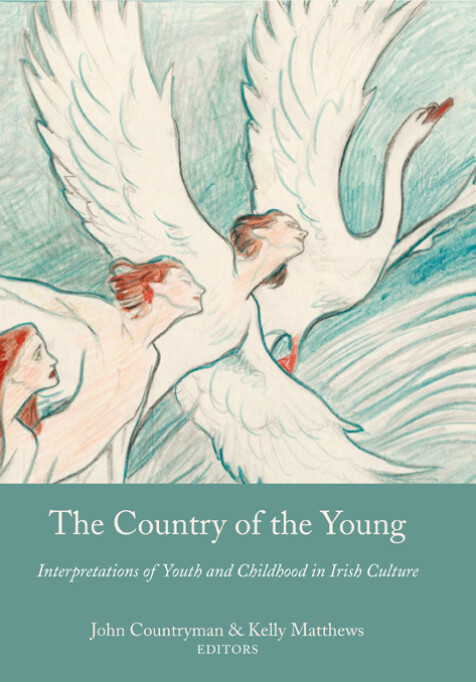The country of the young
Interpretations of youth and childhood in Irish culture
John Countryman & Kelly Mathews, editors
‘[A] stimulating collection of essays … one of the things that makes this particular volume distinct amid recent publications is its engagement with a strikingly diverse range of “cultural products”. The nine essays cover such topics and texts as Irish women’s life-writings, children’s books, novels and short stories not intended for children but featuring child characters, and representations of children, childhood and youth in political propaganda, film, theatre, television and for a range of audiences. There are rich offerings here for readers interested in a variety of subjects and perspectives, including literary studies, history and politics … This interesting book is an excellent contribution to the study of childhood in Irish history and culture … The collection’s particular strength lies in its diversity. By bringing together such a wide range of perspectives on the question of youth and childhood in Irish culture, the book offers some illuminating readings of texts and contexts, both familiar and less well known, and suggests ways in which the current body of important work in this area can continue to flourish’, Beth Rodgers, Canadian Journal of Irish Studies (2015).
‘This collection of essays is dressed in the alluring and exquisite colours of P.J. Lynch’s pencil drawing “The Children of Lir” … This is an insightful choice, calling to mind both the poignant nuances of the legend, and the movement of Irish people and culture throughout the world … In her lucid and scholarly introduction Matthews presents convincing arguments for the relevance of childhood as an object of study … The collection’s thoughtful architecture, in which darker and lighter moments find relief, is one of its strengths. The range of cultural expressions addressed is refreshing … For those with an interest in childhood and Ireland this is a fine book … If the two strands of the importance of cultural studies are the desire that it “be more politically relevant and efficacious and, second, its desire to have an impact on forms of knowledge and on the formations of the academy”, this collection is surely a worthy addition to its bibliography. Not to mention its beautiful cover’, Irish Studies Review (2015).
'This wide-ranging interdisciplinary collection contributes to our knowledge of Irish youth and Irish childhoods through an exploration of films, plays, novels and historical records … Chapters in the volume explore well-worn themes that one has come to expect in an Irish childhood: Catholicism, violence, the Troubles, emigration and abuse. In other ways, the book succeeds in its aim of opening up new areas of research … this interesting and enjoyable collection adds much to a growing body of scholarship that explores positive and negative facets of Irish childhood experiences’, Elaine Farrell, Childhood in the past (May 2015).
‘A complex picture emerges of changing attitudes in society, politics and literature from the 1850s to the present', Books Ireland (May 2013).
‘In an absorbing study of Irish women’s life writings from 1850 to 1950, Cara Delay discusses the influence that mothers had on their daughters’ piety and self-concept … Gavin Foster memorably traces the recasting of young revolutionaries, who were called “heroes” before the civil war of 1922–1924, but renamed “blackguards” during its duration … Countryman and Matthew’s collection of essays by scholars from both the US and Canada will interest scholars of Irish literature and culture. Children’s literature scholars may find new research directions in this thought-provoking, carefully researched collection, along with ideas for comparative literature projects', Jeanette Roberts Shumaker, Children's Literature Association Quarterly (Spring 2014).
‘Builds effectively upon earlier work … the contributors’ specialities include the disciplines of history, literature, drama and cinema; Matthews emphasizes the hope that the diversity of their specialities and critical approaches will serve to continue the scholarly conversation and engender new questions and new research. These essays should certainly do so, and will undoubtedly inspire further critical enquiry and debate. Stellar among the historians’ presentations is Cara Delay’s “Ever So Holy: Girls, Mothers, and Catholicism in Irish Women’s Life-Writings, 1850-1950” … Another outstanding historical essay comes from Gavin Foster, who painstakingly and perceptively explains why “the Irish revolution came to devour its own children” … In the field of literature, [there is] Mary Fitzgerald-Hoyt’s exemplary essay on Claire Keegan [and] Susan Cahill’s excellent discussion of Máirín Cregan’s children’s literature … this book acquits itself well and merits placement in the growing body of material that is scrutinizing Irish childhood', Vivian Valvano Lynch, New Hibernia Review (Spring 2014).
‘The construction of childhood or youth is never an ideologically neutral matter, as this fascinating volume reminds us in its skillful examination of the roles both played in nineteenth- and twentieth-century Irish culture. Drawing upon a rich variety of sources, the essays in the collection explore a diverse range of topics … Taken together, the essays in this collection encourage readers to re-consider their notions of childhood and youth in nineteenth- and twentieth-century Irish culture … this volume clearly demonstrates what can happen when scholars from different disciplines engage in dialogue with each other. The authors here are drawn from a variety of disciplines, and differ in terms of their materials, approaches, and, sometimes, conclusions, but the net effect of their efforts is to remind the reader that the history of Irish culture is marked by strange continuities as well as differences’, Sharon Murphy, Irish Literary Supplement (Spring 2016).

